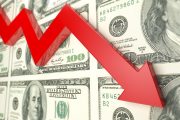
The “Beige Book,” released every six weeks by the Federal Reserve, provides anecdotes from business owners on the state of the economy from their regional perspectives. The latest report, released early this week, confirms the economy’s slowdown and likely slide into recession.
From the Boston district: “Retailers aimed at gently lowering their average prices to consumers … by shifting [their] product mix towards lower-priced items.”
From the New York district: “Hiring has shifted to … replacement rather than growth … many firms have put [their] hiring plans on hold.”
From the St. Louis district: “Production costs rose and are expected to be more persistent, reducing profit margins.”
From Atlanta: “Further weakening [of the economy] could result in future layoffs.”
From Kansas City: “The most significant impediment to loan growth was the [high] level of interest rates.”
Overall, authors of the Beige Book lamented: “Consumer spending ticked down in most districts … manufacturing activity declined in most districts … most districts’ reports indicated softer home sales … employers were more selective with their hires and less likely to expand their workforces, citing concerns about demand and an uncertain economic outlook.”
Job seekers “faced increasing difficulties and longer times to secure a job” and “a number of districts observed that both freight and insurance costs continue to increase.”
Just six weeks earlier the Fed’s report on the economy showed slowing in five of the 12 districts. This week’s report showed weakness in nine of them.
ADP Confirmation
Wednesday’s report from ADP, the country’s largest payroll service provider, confirmed the conclusions from the Fed’s Beige Book. Wall Street predicted job growth for July of 140,000 new jobs. Instead, ADP reported the private sector only produced 99,000, the smallest increase since 2021. The beauty of ADP’s report is that it is “real-time,” based on the earnings of almost 10 million employees served by ADP and monitored daily.
Other reports released this week revealed that job openings across the economy fell to their lowest level in three and a half years, while layoffs increased — the sign of an economy sliding into recession.
The “indicator of indicators,” covered by The New American on Tuesday, summed up the current state of the U.S. economy. Two years ago, out of 20 economic indicators, just two of them were in negative territory. Last year, five of them flashed negative on the economy. This week, the number predicting a recession jumped to nine. Add to that the manufacturing index from the Institute of Supply Management (ISM), which has remained underwater for five straight months, and its Purchasing Managers Report showing the level of new orders at the lowest level in two years, and one could draw the conclusion that the U.S. economy is slipping into recession, if it is not already in the middle of one.
With retailers closing stores and big banks closing branches, consumers’ “optimism index,” prepared for and published by Investor’s Business Daily, has remained in negative territory for more than three years.
Citizens Vote Their Pocketbooks
All of this, as the presidential election draws ever closer, becomes increasingly important. The top two issues among Latino voters, for example, are 1) inflation, and 2) jobs and the economy. Two out of three of them have said they are certain to vote in the upcoming election, making these “pocketbook issues” paramount come November. That’s likely to apply to other voters as well.
Related article:



